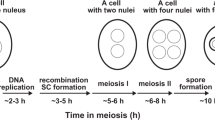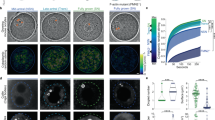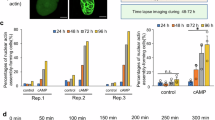Abstract
THE many different cellular functions so far shown to involve actin and to be regulated by specific actin binding proteins are located primarily, if not exclusively, in the cytoplasm1–3. Actin is also found in the nucleus of various cells4–7, but because of the problems of cell fractionation the significance of nuclear actin has remained unclear. The large amphibian oocyte nucleus (germinal vesicle), however, can be isolated manually with little cytoplasmic contamination. This nucleus contains high concentrations (4–6 mg ml−1) of mostly soluble, although polymerization-competent β- and γ-actin8–14, which exists in a nucleocytoplasmic exchange pool15. The findings that drastic effects on transcription and chromosome morphology are caused by the injection of actin antibodies or actin binding proteins into germinal vesicles16,17, and that a factor required for accurate transcription by RNA polymerase II is actin18, suggest that nuclear actin is involved in specific nuclear functions. We have recently identified19,20 two main components in Xenopus laevis oocytes with actin binding activities; one of these activities is Ca2+-dependent, is located predominantly, if not exclusively, in the cytoplasm and is attributable to gelsolin. Here we report that the second component, having a Ca2+-independent activity, is a heterodimeric acting binding protein; this protein is markedly enriched in the nuclei of oocytes and somatic cells of amphibia, but also occurs in nuclei of other vertebrate cells.
This is a preview of subscription content, access via your institution
Access options
Subscribe to this journal
Receive 51 print issues and online access
$199.00 per year
only $3.90 per issue
Buy this article
- Purchase on SpringerLink
- Instant access to full article PDF
Prices may be subject to local taxes which are calculated during checkout
Similar content being viewed by others
References
Weeds, A. Nature 296, 811–816 (1982).
Novick, P. & Botstein, D. Cell 40, 405–416 (1985).
Pollard, T. D. & Cooper, J. A. A. Rev. Biochem. 55, 987–1035 (1986).
Jockusch, B. M., Becker, M., Hindennach, I. & Jockusch, H. Expl Cell Res. 89, 241–246 (1974).
LeStourgeon, W. M. in The Cell Nucleus Vol. 6 (ed. Busch, H.) 305–326 (Academic, New York, 1978).
Kumar, A. et al. Biochemistry 23, 6753–6757 (1984).
Nakayasu, H. & Ueda, K. Expl Cell Res. 163, 327–336 (1986).
Clark, T. G. & Merriam, R. W. Cell 12, 883–891 (1977).
Krohne, G. & Franke, W. W. Expl Cell Res. 129, 167–189 (1980).
Mills, A. D., Laskey, R. A., Black, P. & De Roberts, E. M. J. molec. Biol 139, 561–568 (1980).
Paine, P. L. J. Cell Biol. 99, 188s–195s (1984).
Merriam, R. W. & Clark, T. G. J. Cell Biol. 77, 439–447 (1978).
Gounon, P. & Karsenti, E. J. Cell Biol. 88, 410–421 (1981).
Vandekerckhove, J., Franke, W. W. & Weber, K. J. molec. Biol. 152, 413–426 (1981).
DeRobertis, Longthorne, R. F. & Gurdon, J. B. Nature 272, 254–256 (1978).
Rungger, D., Rungger-Brandle, E., Chaponnier, C. & Gabbiani, G. Nature 282, 320–321 (1979).
Scheer, U., Hinssen, H., Franke, W. W. & Jockusch, B. M. Cell 39, 111–122 (1984).
Egly, J. M., Miyamoto, N. G., Moncollin, V. & Chambon, P. EMBO J. 3, 2363–2371 (1984).
Ankenbauef, T., Kleinschmidt, J. A., Vandekerckhove, J. & Franke, W. W. J. Cell Biol. 107, 1489–1498 (1988).
Ankenbauer, T. thesis, 1–117, Univ. Heidelberg (1988).
Kleinschmidt, J. A. & Franke, W. W. Cell 29, 799–809 (1982).
Kleinschmidt, J. A., Dingwall, C., Maier, G. & Franke, W. W. EMBO J. 5, 3547–3552 (1986).
Schleicher, M., Gerisch, G. & Isenberg, G. EMBO J. 3, 2095–2100 (1984).
Hartmann, H. et al. J. biol. Chem. 264, 12639–12647 (1989).
Garnier, J., Osguthorpe, D. J. & Robson, B. J. molec. Biol. 120, 97–120 (1978).
Schmidt-Zachmann, M., Hügle-Dörr, B. & Franke, W. W. EMBO J. 6, 1881–1890 (1987).
Kilimann, M. W. & Isenberg, G. EMBO J. 7, 889–894 (1982).
Casella, J. F., Maack, D. J. & Lin, S. J. biol. Chem. 261, 10915–10921 (1986).
Casella, J. F., Craig, S. W., Maack, D. J. & Brown, A. E. J. Cell Biol. 105, 371–379 (1987).
Casella, J. F., Casella, S. J., Hollands, J. A., Caldwell, J. E. & Cooper, J. A. Proc. natn. Acad. Sci. U.S.A. 86, 5800–5804 (1989).
Rimm, D. L. & Pollard, T. D. J. Cell Biol. 109, 585–591 (1989).
Author information
Authors and Affiliations
Rights and permissions
About this article
Cite this article
Ankenbauer, T., Kleinschmidt, J., Walsh, M. et al. Identification of a widespread nuclear actin binding protein. Nature 342, 822–825 (1989). https://doi.org/10.1038/342822a0
Received:
Accepted:
Issue date:
DOI: https://doi.org/10.1038/342822a0
This article is cited by
-
The nuclear F-actin interactome of Xenopus oocytes reveals an actin-bundling kinesin that is essential for meiotic cytokinesis
The EMBO Journal (2013)
-
The long journey of actin and actin-associated proteins from genes to polysomes
Cellular and Molecular Life Sciences (2009)
-
Developmental expression of the alpha-skeletal actin gene
BMC Evolutionary Biology (2008)
-
Actin: its cumbersome pilgrimage through cellular compartments
Histochemistry and Cell Biology (2008)
-
An actin fishnet for DNA
Nature Cell Biology (2005)



